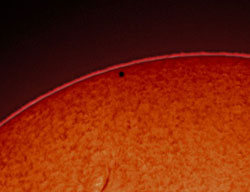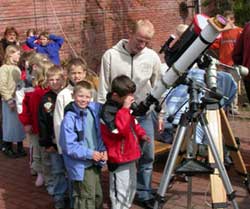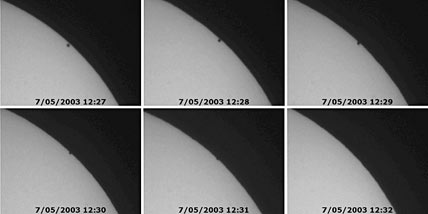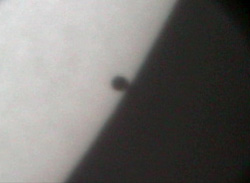
High cloud hampered the view from Sydney, Australia, but Peter Ward still managed to capture this hydrogen alpha view of Mercury beginning its transit of the Sun. He used a 130-mm, f/6 Astro-Physics refractor with a Coronado Ha filter and an SBIG CCD camera.
Clear skies favored much of Europe, Australia, and the Far East, but clouds hindered many observers in eastern North America as the tiny planet Mercury drifted across the face of the Sun on May 7, 2003. Numerous organizations held public viewing sessions, and many amateur astronomers captured the transit using digital cameras.
Anthony Ayiomamitis (Athens, Greece) observed the transit in both hydrogen alpha and white light using a 14-inch Schmidt-Cassegrain telescope and a 70-millimeter Tele Vue Pronto. He writes: "The diminutive 12.0-arcsecond black disk and its very distinct and circular silhouette against a ferocious Sun in Ha could easily have been mistaken for a small sunspot. In the company of AR10151, the sole sunspot noticeably visible through the Ha filter, these two 'sunspots' stood out most prominently at powers as low as 32x."

Observers of all sizes and ages came to see the transit of Mercury during a public event held in Copenhagen, Denmark.
Courtesy Jørgen Albertsen and the Astronomical Society of Køege Bay.
The University of San Carlos Astronomical Society (Cebu City, Philippines) gathered at the soccer field of the Talamban Campus, while the Philippine Astronomical Society set up various observing sites around Manila. The sky was 70-percent clear, and despite the heat (the temperature was 40° Celsius), observing continued until the transit ended with sunset.
"The weather along the eastern coast of the USA was dominated by a low-pressure system that kept most of the region under clouds and fog," according to Fred Espenak (NASA/Goddard Space Flight Center). "Nevertheless, four of us got a fine view of the transit from North Beach, Maryland (about 25 miles south of Annapolis). There was a lot of variable fog and a band of clouds along the horizon. In spite of these adverse conditions, the Sun and Mercury became visible about 5 minutes after sunrise. The event ended just 25 minutes after sunrise with the Sun just 6 degrees above the horizon."
Observers living outside the transit zone (or whose view was spoiled by clouds) could watch the event unfold courtesy of numerous amateur and professional organizations that successfully webcast the event. For those who missed the event, images of the transit are available on a number of sites including:
- European Southern Observatory
- National Solar Observatory
- Swedish Solar Telescope
- Solar and Heliospheric Observatory (SOHO)

On May 7, 2003, astronomers and the public gathered at MIRA Observatory in Grimbergen, Belgium, to watch Mercury cross the Sun's face. These images were grabbed from the observatory's live webcast as the planet exited the solar disk. Philippe Mollet used a 200-millimeter (7.9-inch) f/6.6 Newtonian reflector, Baader solar filters, and a Philips Vesta Pro webcam.
Courtesy MIRA Observatory.
To help in planning future transit articles (see the next page), Sky & Telescope continues to seek contact timings made on May 7th. In your report, please include your latitude and longitude to the nearest arcminute, telescope aperture, and the magnification or the diameter of the projected solar disk used in making the timings. Send reports by e-mail to [email protected].
Upcoming Events

Despite high cirrus and rapidly fluctuating seeing, Sky & Telescope associate editor Adrian Ashford managed to extract this frame from video shot at third contact during Mercury's May 7th transit. His Samsung miniDV camcorder was used afocally at maximum zoom behind a 25-mm Plössl eyepiece in the visual back of his filtered 8-inch telescope.
This was the first of 14 transits of Mercury to take place during the 21st century and the first transit to occur during the month of May in more than three decades. Mercury’s transits occur in May or November, but in no other month, because the planet’s orbit plane is inclined 7° to that of Earth, and the geometry is then favorable for an exact lineup. Moreover, Mercury reaches the aphelion point in its orbit (farthest from the Sun) in May, at which time the planet shows a relatively large disk (12.0" during the May 7th event). During a November transit the situation is reversed: Mercury is near perihelion (closest to the Sun), and its diameter never exceeds 10.0".
Mercury’s next transit of the solar disk favors observers in Pacific Rim countries. This event takes place in 2006 on the afternoon of November 8th in the Americas, and the morning of November 9th west of the International Date Line.
Yet for many observers this May’s transit was a warm-up session for a far grander spectacle, one that no person alive today has ever seen. The planet Venus will cross the disk of the Sun on June 8, 2004, for nearly the same regions of the Earth, and at the same time of day, as did Mercury on May 7, 2003. Compared to puny Mercury, Venus’s silhouette will appear five times wider and 23 times bigger in area — producing a fairly obvious naked-eye "sunspot"!
 0
0
Comments
You must be logged in to post a comment.